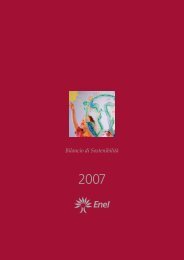Annual Report 2010 - Enel.com
Annual Report 2010 - Enel.com
Annual Report 2010 - Enel.com
You also want an ePaper? Increase the reach of your titles
YUMPU automatically turns print PDFs into web optimized ePapers that Google loves.
Inventories also include purchases of nuclear fuel, whose<br />
use is determined on the basis of the energy produced.<br />
Construction contracts<br />
Construction contracts are measured on the basis of the<br />
contractual amounts accrued with reasonable certainty in<br />
respect of the stage of <strong>com</strong>pletion of the works as determined<br />
using the cost-to-cost method. Advances paid by<br />
customers are deducted from the value of the construction<br />
contracts up to the extent of the accrued amounts;<br />
any excess is recognized under liabilities. Losses on individual<br />
contracts are recognized in their entirety in the<br />
period in which they be<strong>com</strong>e probable, regardless of the<br />
stage of <strong>com</strong>pletion of the contract.<br />
Financial instruments<br />
Financial assets measured at fair value through<br />
profit or loss<br />
This category includes debt securities and equity investments<br />
in entities other than subsidiaries, associates and<br />
joint ventures held for trading and designated as at fair<br />
value through profit or loss at the time of initial recognition.<br />
Such assets are initially recognized at fair value. Gains and<br />
losses from changes in their fair value are recognized in<br />
the in<strong>com</strong>e statement<br />
Financial assets held to maturity<br />
This category <strong>com</strong>prises non-derivative financial instruments<br />
with fixed or determinable payments and that do<br />
not represent equity investments that are quoted on an<br />
active market for which the Group has the positive intention<br />
and ability to hold until maturity. They are initially<br />
recognized at fair value as measured at the trade date,<br />
including any transaction costs; subsequently, they are<br />
measured at amortized cost using the effective interest<br />
method, net of any impairment losses.<br />
Impairment losses are calculated as the difference between<br />
the carrying amount of the asset and the present value of<br />
expected future cash flows, discounted using the original effective<br />
interest rate.<br />
Loans and receivables<br />
This category includes non-derivative financial and trade<br />
receivables, including debt securities, with fixed or determinable<br />
payments that are not quoted on an active market<br />
that the entity does not originally intend to sell.<br />
Such assets are initially recognized at fair value, adjusted<br />
for any transaction costs, and subsequently measured at<br />
amortized cost using the effective interest method, net of<br />
any impairment losses. Such impairment losses are calculated<br />
as the difference between the carrying amount of<br />
the asset and the present value of expected future cash<br />
flows, discounted using the original effective interest rate.<br />
Trade receivables falling due in line with generally accepted<br />
trade terms are not discounted.<br />
Financial assets available for sale<br />
This category includes debt securities, equity investments<br />
in other entities (not classified as “designated as at fair value<br />
through profit or loss”) and financial assets that cannot<br />
be classified in other categories. These instruments are<br />
measured at fair value with changes recognized in shareholders’<br />
equity.<br />
At the time of sale, the cumulative gains and losses previously<br />
recognized in equity are reversed to the in<strong>com</strong>e<br />
statement.<br />
Where there is objective evidence that such assets have incurred<br />
an impairment loss, the cumulative loss previously<br />
recognized in equity is eliminated through reversal to the<br />
in<strong>com</strong>e statement. Such impairment losses, which cannot<br />
be reversed, are calculated as the difference between the<br />
carrying amount of the asset and its fair value, determined<br />
on the basis of the market price at the balance sheet date<br />
for financial assets listed on regulated markets or on the<br />
basis of the present value of expected future cash flows,<br />
discounted using the market interest rate for unlisted financial<br />
assets.<br />
When the fair value cannot be determined reliably, these<br />
assets are recognized at cost adjusted for any impairment<br />
losses.<br />
Cash and cash equivalents<br />
This category is used to record cash and cash equivalents<br />
that are available on demand or at very short term, clear<br />
successfully and do not incur collection costs.<br />
Cash and cash equivalents are recognized net of bank<br />
overdrafts at period-end in the consolidated statement of<br />
cash flows.<br />
Trade payables<br />
Trade payables are initially recognized at fair value and<br />
subsequently measured at amortized cost. Trade payables<br />
falling due in line with generally accepted trade terms are<br />
not discounted.<br />
161









